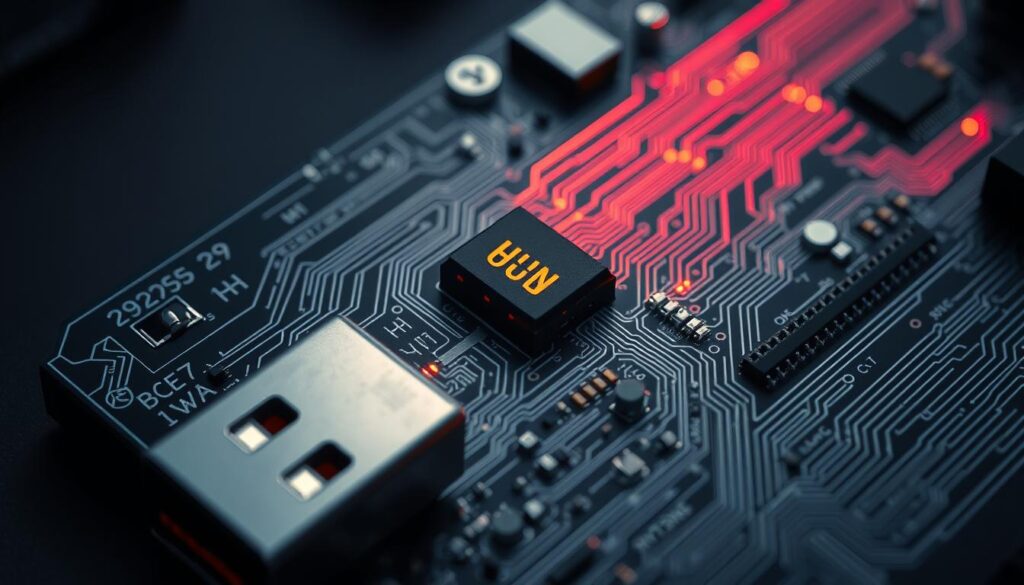Researchers have hacked into Apple’s ACE3 USB-C controller. This is a big deal because it’s used in the iPhone 15 and iPhone 15 Pro. They found a way to get past Apple’s strong security.
This shows that even the newest tech can be hacked. They used smart hacking tricks to do it. This means we need to keep getting better at keeping our devices safe.
Key Takeaways
- The ACE3 USB-C controller is essential for iPhone 15 functionality.
- This USB-C controller hack exemplifies flaws in even advanced security systems.
- Approximately 100 million macOS users could be affected by related vulnerabilities.
- The hacking methods involved reverse engineering and electromagnetic fault injection.
- Apple has acknowledged the issue but labeled it as non-threatening.
- The findings stress the importance of continuous advancements in security protocols.
- Collaboration between researchers and manufacturers is crucial for enhancing device security.
Introduction to the USB-C Controller Hack
A recent Apple hacking incident has scared many in the tech world. News about this shows a big increase in attempts to find weak spots in Apple’s new USB-C controller, called the ACE3. This chip, made by Texas Instruments, has 120 pins. It’s very complex and advanced compared to the old TPS65986 chip.
Apple’s switch to USB-C is big news. It means they must quickly fix any security problems with the new hardware. Knowing the risks of the ACE3 is key. The old chips had flaws that let hackers access them, but the ACE3 has new security that stops this.
But, hackers are still finding ways to get around these new protections. They use tricks like sending electromagnetic waves to mess with the chip. A report says hackers are using special methods to find and use these weak spots.
Apple keeps making new tech, but they must also keep it safe. This is a big challenge. They need to keep making new things while also protecting against hackers.
Overview of Apple’s ACE3 USB-C Controller
Apple has moved to the ACE3 USB-C controller, a big step forward. This chip makes USB-C better in devices like the iPhone 15 and new Macs. It does more than just USB stuff. It also manages power and talks to the inside of the device.
What is the ACE3 Chip?
The ACE3 chip is a strong, special USB-C controller. It has a full USB stack and a “Port DFU” mode. It has 120 pins, more than the ACE2.
The ACE3 is more secure than the ACE2. It doesn’t let you get direct access like JTAG. The flash memory is small, checked with crypto.
Importance of the USB-C Transition in Apple’s Devices
Switching to USB-C is a big deal for Apple. It makes devices work better with more accessories. This change makes things easier for users and fixes security issues.
Apple’s move with the ACE3 chip will help everyone. Devices will charge and connect better. This changes how we use technology.

Researchers Hacked into Apple’s New USB-C Controller
A recent hack into Apple’s ACE3 USB-C controller showed big security problems. At the 38C3 conference, experts shared how they did it. They used cool tricks like reverse engineering and electromagnetic fault injection.
These methods let them run code on the ACE3 chip. This made Apple’s security look weak.
Details of the Hacking Incident
The hack was about the ACE3 chip, which is new in Apple devices. It’s used for things like charging and talking to the SoC. Hackers found ways to get into the chip’s firmware.
This let them see how it works and find its weak spots.
Methods Used by Researchers
The hackers used many ways to get into the chip. Here are a few:
- Reverse Engineering: They took apart the firmware to learn about the ACE3.
- Electromagnetic Fault Injection: They used the chip’s own signals to make it do things it shouldn’t.
- RF Side-Channel Analysis: They listened to the chip’s radio waves to figure out what it was doing.
These methods showed that Apple’s security still has big holes. This could lead to more research and better security in the future.
Significance of the Hack in Cybersecurity
The recent hacking incident involving Apple’s new USB-C controller has big implications for cybersecurity. It shows how vulnerable Apple devices can be. This is a big problem in the tech world.
Implications for Apple Device Security
The hack can let hackers get into user data and control systems. This is a big risk. Apple needs to make its devices safer.
Reports show cyberattacks are going up a lot. The UK saw a huge jump in cyberattacks in November 2024. This is a warning for Apple users.
Broader Impact on Smartphone Security
This hack is not just a problem for Apple. Smartphones are key for our daily lives. They hold our personal info and money.
More and more big hacks are happening. This means we all need to be careful. Phone makers must keep up with new hacking tricks.
| Time Period | Description | Impact |
|---|---|---|
| November 2024 | Three-fold increase in significant cyberattacks reported by the UK’s National Cyber Security Center | Heightened insecurity across multiple sectors, including telecommunications and consumer devices |
| Ongoing | Breaches by Chinese hackers across U.S. and Canadian networks | Increased governmental and corporate scrutiny on cybersecurity |
| October 2024 | Ransomware attack on Indonesia’s national data center | Disruption of critical services and governmental processes |
| July 2024 | Faulty software update by CrowdStrike leading to $5.4 billion losses | Reevaluation of software integrity and security protocols in tech companies |
The Role of Advanced Hacking Techniques
A recent hack of the USB-C controller showed how advanced hacking works. It was done by researchers who found weak spots in Apple’s ACE3 controller. This shows why we need strong security to protect our devices.
Reverse Engineering and Firmware Analysis
Reverse engineering was a big part of the hack. Researchers took apart the hardware and looked at its firmware. They found hidden weaknesses and ways to get in.
This shows how devices can be attacked. It’s a warning to keep our devices safe from hackers.
Side-Channel Analysis and Electromagnetic Fault Injection
Researchers also used side-channel analysis and electromagnetic fault injection. These methods use hidden signals to get into the controller. They can get into the chip without the usual ways.
This shows how hard it is to keep devices safe. Hackers keep finding new ways to get in.
| Technique | Description | Risk Level |
|---|---|---|
| Reverse Engineering | Dissecting hardware and firmware to identify vulnerabilities. | High |
| Firmware Analysis | Examining software code for security loopholes. | Medium |
| Side-Channel Analysis | Using emissions to extract sensitive data without direct access. | High |
| Electromagnetic Fault Injection | Deliberately causing faults in hardware to bypass security. | Very High |
Potential Vulnerabilities and Risks
Apple’s ACE3 controller has big problems in the world of cybersecurity. Finding these problems shows we need to act fast. With more devices connected, hackers have more ways to get in.
Risks Associated with the ACE3 Controller Vulnerability
Experts say the ACE3 controller problem could let hackers get into our stuff. With more devices around, hackers have more ways to get in. This could let them mess with our devices and even bigger systems.
Threats Posed by Cybercriminals
Hackers keep finding new ways to get into our stuff. The ACE3 controller problem could let them do big attacks. This could hurt companies a lot and make people lose trust.
Response from Apple and the Security Community
Apple has acted after a recent hacking incident. The company has talked about the research findings. It says it’s all about keeping users safe and private.
Apple is checking its security rules. It wants to protect against new USB-C tech problems.
Apple’s Statement on the Hacking Research
Apple says it’s always working to get better at keeping things safe. It’s happy to say most users have the latest software. This shows Apple is doing its best to keep risks low.
Apple tells users it’s looking into the latest news. It’s making sure devices are safe from threats.
Community Reactions to the Security Breach
The security world is backing the research. They see it as a chance to fix USB-C problems. Forums show many people want better security for these connections.
Some worry about USB-C being used to harm devices. The industry is coming together to face these issues. The Apple security breach is a big topic right now.
Future Directions for Apple and Security Research
The Apple hacking incident with the ACE3 USB-C controller is a big problem. Apple is moving to ARM-based processors. This means they need to focus more on security.
Fixing these issues will make their devices safer. It will also help people trust Apple more.
Possibilities for Enhanced Security Measures
Apple might take several steps to improve security. This is based on a detailed report about the ACE3 controller. Some ideas include:
- Using stronger encryption for updates.
- Protecting debug interfaces better to stop hacking.
- Adding hardware security to fight off attacks.
Implications for Future Chip Development
The ACE3 controller’s problems make Apple rethink chip design. Future chips need to be strong against attacks. Apple might consider:
- Creating chips that resist electromagnetic attacks.
- Having a strong check during startup to prevent hacking.
- Doing lots of tests to make sure security works.
Conclusion
The recent USB-C controller hack shows how fast cyber threats change. Even Apple, known for being secure, can get hacked. This hack shows that no system is completely safe.
Apple’s macOS uses IOMMU well, but it still had weak spots. The “Thunderclap” incident showed how USB-C and Thunderbolt 3 can be vulnerable. This is a big worry for everyone.
This hack is a wake-up call for the tech world. We need to mix new tech with strong security. USB-C ports can be a big risk if not used carefully.
Malicious charging stations are a big problem. We need to stay alert to keep our devices safe. Working together, we can make our tech safer.
This hack is a warning for better security. Cyberattacks can really hurt businesses and users. We must act fast to keep our systems safe.


